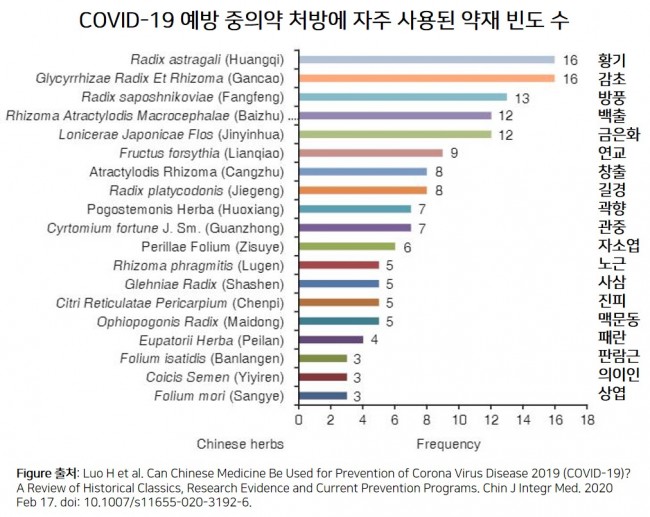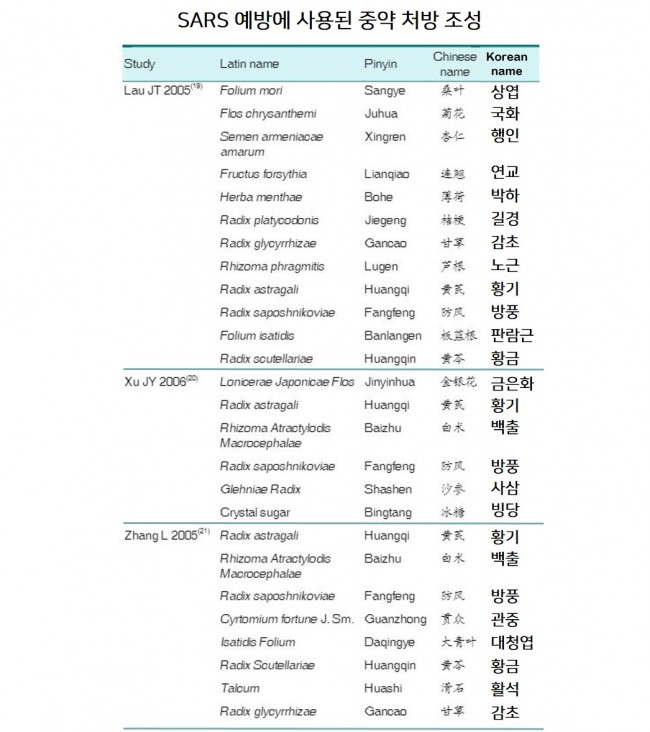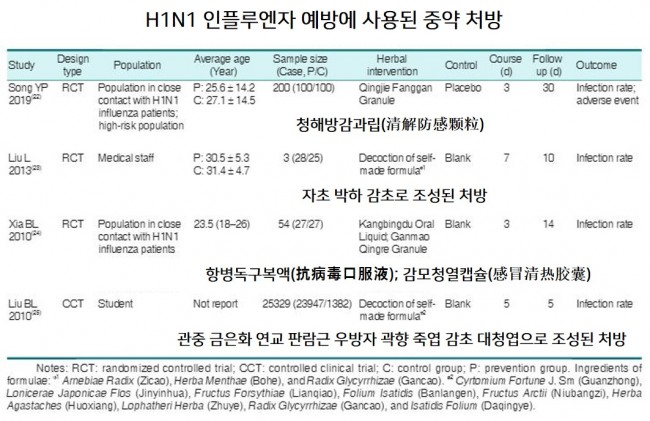동향분석
Home > 뉴스브리핑센터 > 동향분석| COVID-19 예방 중의약 처방에 자주 사용된 약재는? (Chin J Integr Med. 2020 Feb 17) |
|
중의약을 코로나 바이러스 2019 질병 예방에 사용할 수 있을까? 고문헌, 연구 근거, 현재 예방 프로그램의 리뷰 Can Chinese Medicine Be Used for Prevention of Corona Virus Disease 2019 (COVID-19)? A Review of Historical Classics, Research Evidence and Current Prevention Programs. Chin J Integr Med. 2020 Feb 17. doi: 10.1007/s11655-020-3192-6. Hui Luo 1 2, Qiao-Ling Tang 3, Ya-Xi Shang 2 3, Shi-Bing Liang 2 3, Ming Yang 2 3, Nicola Robinson 2 4, Jian-Ping Liu 5 6 1 Institute for Tibetan Medicine, China Tibetology Research Center, Beijing, 100101, China. 2 Centre for Evidence-Based Chinese Medicine, Beijing University of Chinese Medicine, Beijing, 100029, China. 3 School of Traditional Chinese Medicine, Beijing University of Chinese Medicine, Beijing, 100029, China. 4 School of Health and Social Care, London South Bank University, London, SE1 0AA, UK. 5 Centre for Evidence-Based Chinese Medicine, Beijing University of Chinese Medicine, Beijing, 100029, China. jianping_l@hotmail.com. 6 Institute of Integrated Traditional Chinese Medicine and Western Medicine, Guangzhou Medical University, Guangzhou, 510120, China. jianping_l@hotmail.com. Abstract 목적: 2019년 12월 이후 중국 우한에서 코로나 바이러스 2019 (COVID-19) 질병이 발생하여 중국의 거의 모든 지역으로 빠르게 확산되었다. 그 후 예방을 위해 중의약을 권장하는 프로그램이 이어졌다. 중의약 권고에 대한 근거를 제공하기 위해 고문헌과 임상 연구를 검토했다. 방법: 중의약 고문헌의 감염 예방 및 치료에 대한 과거 기록, 중증 급성 호흡기 증후군 (SARS) 및 H1N1 인플루엔자 예방에 대한 중의약의 임상 근거, COVID-19 발병 이후 중국 보건당국이 발행한 중의약 예방 프로그램, 2020년 2월 12일까지 다른 데이터베이스와 웹 사이트에서 검색했다. 연구 근거는 전염성 호흡기 바이러스 질병 예방을 위해 중의약을 사용한 임상 시험, 코호트 또는 기타 인구 기반 연구의 데이터를 포함한다. 결과: 고대 중국의 <황제내경>에는 전염병을 예방을 위해 중의약을 사용했다고 기록되어 있다. SARS 예방을 위해 중의약을 사용한 3건의 연구와 H1N1 인플루엔자에 예방에 대한 4건의 연구가 있었다. 중의약 치료를 한 참가자 중 3명은 SARS에 걸리지 않았다. 중의약 치료 그룹에서 H1N1 인플루엔자의 감염률은 중의약 치료를 안한 그룹보다 유의하게 낮았다 (상대 위험 0.36, 95% 신뢰구간 0.24-0.52; n = 4). COVID-19 예방을 위해 중국의 23개 성에서 중의약 프로그램을 시행했다. 중의약 사용의 주요 원칙은 외부 병원체로부터 보호하고 풍을 분산시키고 열을 발산하며 습을 없애 기를 강화하는 것이다. 가장 자주 사용된 중약은 황기, 감초, 방풍, 백출, 금은화, 연교다. 결론: SARS 및 H1N1 인플루엔자 예방에 대한 역사적 기록과 임상 연구에 근거하여, 중의약 처방은 고위험군에서 COVID-19를 예방하기 위한 대안적 접근법이 될 수 있다. 중의약의 잠재적 예방 효과를 확인하기 위해 전향적이고 철저한 인구 기반의 연구가 필요하다. OBJECTIVE: Since December 2019, an outbreak of corona virus disease 2019 (COVID-19) occurred in Wuhan, and rapidly spread to almost all parts of China. This was followed by prevention programs recommending Chinese medicine (CM) for the prevention. In order to provide evidence for CM recommendations, we reviewed ancient classics and human studies. METHODS: Historical records on prevention and treatment of infections in CM classics, clinical evidence of CM on the prevention of severe acute respiratory syndrome (SARS) and H1N1 influenza, and CM prevention programs issued by health authorities in China since the COVID-19 outbreak were retrieved from different databases and websites till 12 February, 2020. Research evidence included data from clinical trials, cohort or other population studies using CM for preventing contagious respiratory virus diseases. RESULTS: The use of CM to prevent epidemics of infectious diseases was traced back to ancient Chinese practice cited in Huangdi's Internal Classic (Huang Di Nei Jing) where preventive effects were recorded. There were 3 studies using CM for prevention of SARS and 4 studies for H1N1 influenza. None of the participants who took CM contracted SARS in the 3 studies. The infection rate of H1N1 influenza in the CM group was significantly lower than the non-CM group (relative risk 0.36, 95% confidence interval 0.24-0.52; n=4). For prevention of COVID-19, 23 provinces in China issued CM programs. The main principles of CM use were to tonify qi to protect from external pathogens, disperse wind and discharge heat, and resolve dampness. The most frequently used herbs included Radix astragali (Huangqi), Radix glycyrrhizae (Gancao), Radix saposhnikoviae (Fangfeng), Rhizoma Atractylodis Macrocephalae (Baizhu), Lonicerae Japonicae Flos (Jinyinhua), and Fructus forsythia (Lianqiao). CONCLUSIONS: Based on historical records and human evidence of SARS and H1N1 influenza prevention, Chinese herbal formula could be an alternative approach for prevention of COVID-19 in high-risk population. Prospective, rigorous population studies are warranted to confirm the potential preventive effect of CM.
논문 출처: https://www.ncbi.nlm.nih.gov/pubmed/32065348 KMCRIC Notes: Pogostemonis Herba 광곽향, Cyrotomium fortune J.Sm. 쇠고비, Folium isatidis 대청엽, Radix saposhnikoviae 해방풍(북사삼)으로 수정합니다. |











